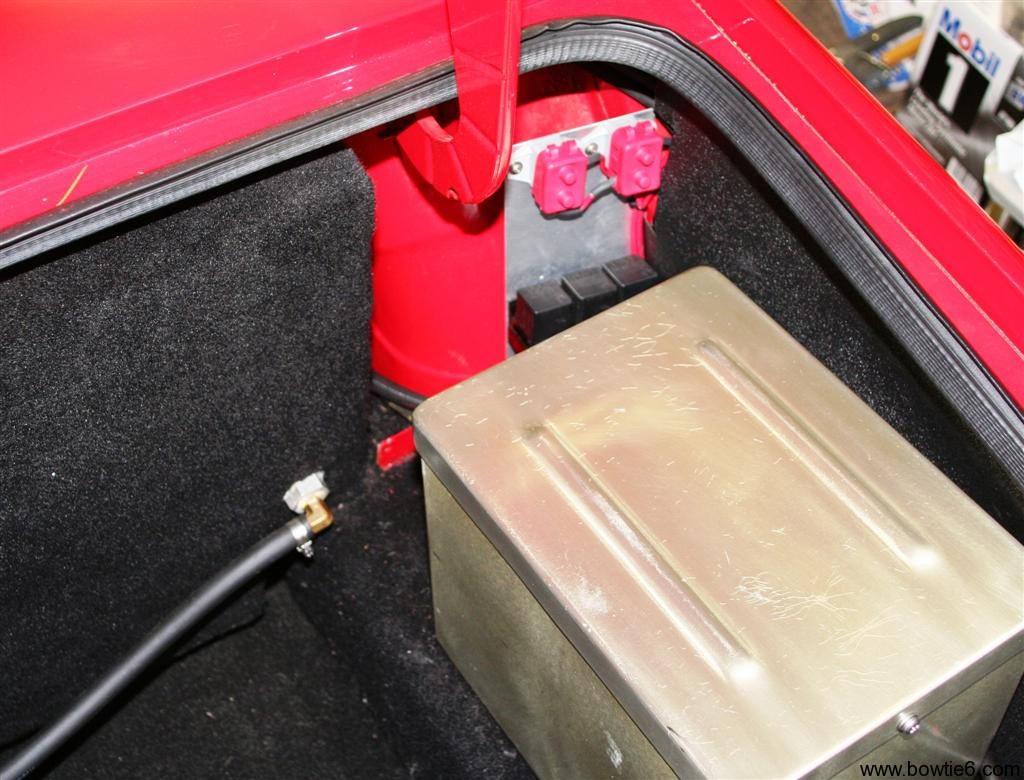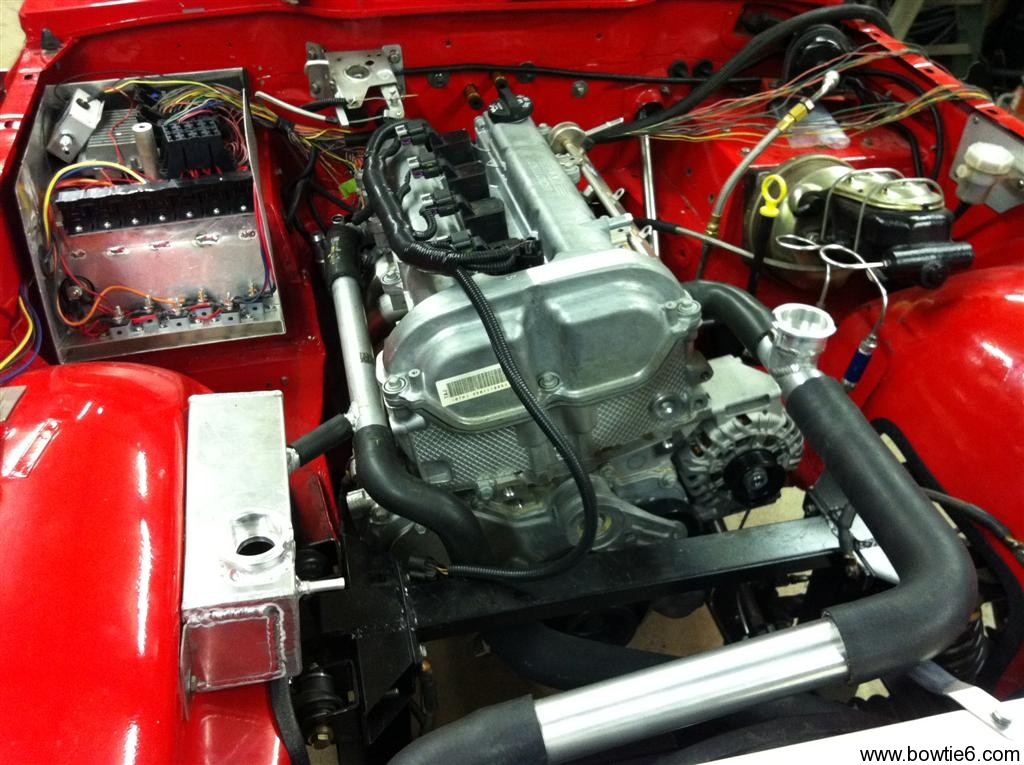The last post talked about the harness and fuse box under the hood. Today’s post shows the wiring in the trunk.
Since we are far from “original”, I wired up bowtie6 in a practical way. There is a fusebox in the engine compartment (as discussed previously), one in the cab compartment (to be discussed) and one in the trunk (discussed here). Why go through all this trouble?
Well, for starters I wanted to keep things simple. But mainly because there was not enough room underneath the hood! Besides, it makes sense to control things where they belong and in the trunk there are several things to control…
Battery
The Optima Red-Top dry cell battery in bowtie6 is mounted in an aluminium enclosure pictured above. The B+ terminal has a welding machine cable attached to it and it runs inside the TR6’s cab and ties into the firewall post. The ground terminal is also a welding machine cable going through the body and securely bolted to the frame. In the engine compartment, there are two more welding machine cables grounding the body and the engine to the frame. Finally, there is a B+ lead from the battery to two circuit breakers mounted in a special mount that control the following:
- Fuel Pump
- Backup Lights
- Brake Lights
Fuel Pump
The ECOTEC needs a high pressure fuel supply. This comes from a GM high pressure pump as fitted to late-model Corvettes. We used that pump because it is very small, has a filter “sock” and can be mounted in a small enclosure. In the picture above you can see the fuel pump enclosure – that is the aluminium box resting on the trunk’s floor. I’ve written about this before but basically that is an external tank plumbed to the main custom made all aluminium fuel tank. We have about a 300 mile range in city driving with this setup. I am sure it will be more once we do a long, highway trip.
 The picture above shows two circuit breakers and three relays. The fuel pump has one of the relays and one of the circuit breakers. The control side of the relay is fed from a signal from the ECM. When done right, the ECM sends a 5 second signal and energizes the pump. This primes the fuel rail and gets things ready for ignition. Once the engine fires, the ECM re-energizes the relay and that keeps the pump running until the ignition switch is turned off.
The picture above shows two circuit breakers and three relays. The fuel pump has one of the relays and one of the circuit breakers. The control side of the relay is fed from a signal from the ECM. When done right, the ECM sends a 5 second signal and energizes the pump. This primes the fuel rail and gets things ready for ignition. Once the engine fires, the ECM re-energizes the relay and that keeps the pump running until the ignition switch is turned off.
Backup Lights
The AISIN 5 speed gearbox has a built in switch that makes ground when the stick engages reverse. I took advantage of this to make the TR6’s backup lights work. Basically since this is a switch and it makes ground, I wired this into the control circuit of a relay. This minimizes wear on the switch and voilà, we have backup lights.
Brake Lights
Ah! Brake lights!! As you had guessed, I used a relay to run the brake lights. As with the fuel pump and backup lights there is a hard voltage circuit from B+ on the battery to the relay. This is controlled by breaking ground on the brake pedal switch. Simple. Brakes work flawlessly and will be there forever – the brake switch breaks ground.
In Summary
Once again, I realize this is borderline overkill. However, this makes things very simple and easy to fix if need be. Setting this back circuitry together took little time and works like a charm. As with the engine compartment fuse box, I added red “booties” to the circuit breakers. You can also see the trunk floor is fully covered in black carpet now.
Here is a closeup of the rear wiring:
If you look close enough you will see several things here…
- The lid to the battery box. The box is made from aluminium and bolted securely to the side floor of the trunk. This is mounted on the passenger’s side to even out weight distribution. As mentioned previously, the battery is a dry cell Red Top Optima battery. They are very durable and although they are expensive, they are very worth the cost.
- The black plastic background. That is ABS material pre-bent and cut to fit the sides of the trunk. There is one on all sides, including the inside back of the trunk. I used this because it is very easy to work with and can be shaped with simple tools such as scissors and a break. This stuff is also very durable and looks very clean. Much superior to the crappy cardboard “trunk liner” kits sold by the Big Three vendors.
- The aluminium plate holds three relays and two circuit breakers. I’ve discussed these above.
- Finally, if you really look close you can see two rubber hoses right behind the circuit breakers. What is this all about? Well, my bowtie6 is from the very fine 1972 vintage. In 1972 a special “tank” was affixed to the inside of the passenger’s side trunk. This tank had two lines attached to it. The first line came from a vent on the fuel filler neck. The other line was routed to the intake. This ensured all fuel tank fumes get routed back to the engine. This has been retained and is fully operational in bowtie6.
Attention to detail? Hell yes.
There are so many small details on bowtie6 that get overlooked! However, I know they are there and this makes the difference. With this TR6, there is not only killer looks in the form of a very shiny paint job, a powerful engine and a great handling frame but there are also countless details that separate this from even “restored” examples…










